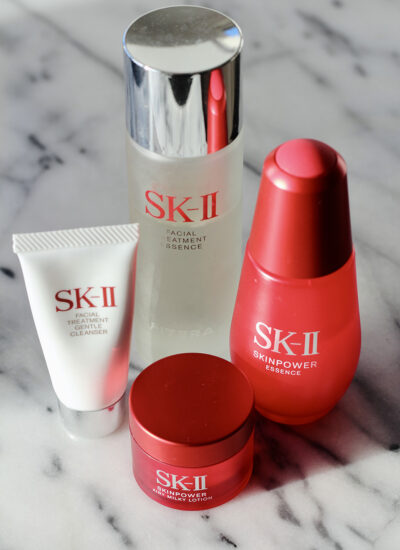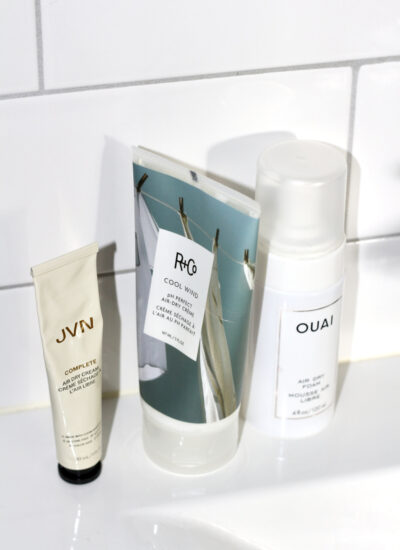
I was recommended to use Tebiskin LC after a small pigmentation mark had appeared after my treatment of TCA chemical peel. While the Dermastamp treatment I was going to have next would probably “clean up” the mess of the TCA – as needling is very effective to remove pigmentation marks – I still asked if there’s was any lightening cream I could use to help it a bit further. And it was just my luck that the clinic was offering high discount prices on old Tebiskin products!
A TCA peel isn’t really recommended for those of darker skin or those who produce more melanin. And with me being half Moroccan who tans very easily, there’s a possible chance of getting pigmentation marks. TCA peel can also bring old pigmentation marks up to the surface that were hidden under the skin, and will be removed with continued peels. However, after a discussion with my facialist, we came to the conclusion that it may have been due to my skin peeling too fast. Normally you want the dead skin to sit for a few days. During my first time, I peeled at the end of the third day and the beginning of the fourth (this is normal). And this time I started to peel in the evening of the second day. According to my facialist, that’s a bit too soon for your skin to have healed, and then these darker spots may appear.
In the end, the mark disappeared. Whether it was from this cream or the Dermastamp or both, I can’t completely be sure. But I can talk about my overall impression of this cream!

Tebiskin LC (Lightning Cream)
Tebiskin LC is made to prep the skin before various medical procedures to prevent the risk of post-inflammatory hyperpigmentation. It targets specifically the pigmentation and reduces the intensity of skin hyperpigmentation of melanin origin.
I got this cream for 100SEK instead of the retail price of 600SEK, as they were rebranding and reformulating their products. The new Tebiskin products will have a slightly different ingredient list.
First off, it’s a cream. It can be used alone (under a sunscreen) or as a serum. I used it as a serum as the cream itself wasn’t hydrating enough. It’s been a long time since I used cream products, and from the ones I’ve started experimenting with, this one had the best texture of them all. When you apply it goes fluidly on and sinks in fast.
It doesn’t have any sparkling bits in it as many other brightening creams have, but still, you may experience a brighter complexion quite instantly.
It does contain alcohol quite high up on the list and therefore it can be a bit drying, but as long as you use a moisturizer on top it shouldn’t be too big of a problem. But it’s probably because of it, that this cream feels a bit dry on its own.
NO Hydroquinone or Arbutin
The Tebiskin LC is free from Hydroquinone and Arbutin (a glycoside of Hydroquinone), which are the most effective lightening ingredients on the market. But not only do they come with some side effects, they are banned in the EU to use in cosmetics. However, some natural skincare products do work around this, and use Bearberry extract in their products, which naturally contains the active agent Arbutin. Arbutin is usually extracted from Bearberries. One such product that contains Bearberry extract is the popular Yüli Cell Perfecto PM serum – probably the reason why it’s so good.
The reason these ingredients are so strictly supervised is that, like any skin lightening ingredient, it makes you prone to sun sensitivity and various skin cancers. But the studies were done including extremely high doses of Hydroquinone, and can simply be fixed by advocating sunscreen use while using lightening products (which is really just common sense). As well as promoting usage during winter and for no more than 4 weeks at a time.
But Tebiskin went another route and combined four other active ingredient that they claim is equivalent to 4% Hydroquinone.
Key Ingredients
- Ethyl Linoleate ? Essential fatty acid ester helps promote even looking skin tone and helps support barrier function.
Information: http://www.paulaschoice.com/cosmetic-ingredient-dictionary/definition/linoleic-acid - Acetyl Glucosamine – acetyl glucosamine is considered to be a “skin-identical ingredient”, meaning it’s found in our skin in the spaces between the cells, and it is used to maintain skin’s barrier abilities and reduce dryness. Studies have shown that NAG can increase collagen production, increase the moisture content of the skin, increase the elasticity of the skin, increase exfoliation, and increase the speed of wound healing. It has also been shown to reduce hyperpigmentation and can be combined with niacinamide to further increase its ability to reduce hyperpigmentation.
Information: http://www.paulaschoice.com/cosmetic-ingredient-dictionary/definition/acetyl-glucosamine - SymWhite® 377 (INCI: Phenylethyl Resorcinol) – is inspired by pinosylvin, a natural skin brightening compound occurring in pine. It was synthesized and screened for tyrosinase inhibitory activity as well as for antioxidant efficacy.It is a synthetic compound that is partially derived from natural lightening compounds found in scotch pine bark and is considered a reliable whitening agent.
Studies published by Symrise (no independent studies were found).
Information: http://www.paulaschoice.com/cosmetic-ingredient-dictionary/definition/phenylethyl-resorcinol - Ferulic Acid – Plant-based antioxidant that is found in bran, among other plants.It’s one of the most powerful natural anti-oxidants. Many plants contain Ferulic acid, which plays a key role in the plants self preservation mechanism, re-enforcing it’s cellular wall strength and protecting it from microbial damage as well as sun damage. Used as a anti-oxidant extender, for many of the other anti-oxidants. In particular the combination of Vitamins C, and E, were shown to double their photo protective capacity on the skin. It is well known that Vitamin C is very problematic in skin care due to it’s highly oxidative state, and Ferulic Acid prevents the oxidation.
CONCLUSION
Because I used this in conjunction with a Dermastamp treatment, I can’t really tell how effective it is on its own. The pigmentation disappeared within 1-2 weeks after treatment. Even though I kept on using the cream for two months more with a slight break during the summer, I can’t say that I’ve noticed any huge results during those days I did not use it. But then again, I only had that one and only pigmentation-concern. While it did seem to have some effect on post-redness from acne, I felt like the cream became more problematic with continued use because of it’s drying alcohol content.
I was told that it works slow, and that I should give it 6 months. But the cream itself lasts about 3 months with everyday use. One thing I liked with it though, was that it didn’t seem to turn my face white, like many hydroquinone-products usually do. So this is a good option for those with more tanned/darker skin. I wish you all could’ve paid as little as I did to test for yourself if it works.
After I purchased it, I’ve discovered so many more lightening products, good ones, that doesn’t have the high price of Yüli serum or even the original price of this one!
It also depends on what type of pigmentation you’re trying to treat. If it’s a large area, or like the one dark-spot I got from the TCA peel, then I highly recommend Dermastamp. It’s just so effective! Even a TCA peel is good at removing spots and making your complexion even, but Dermastamp in my opinion is much safer and you’ll see results within a few weeks.
If it’s red spots from acne/pimples then there are milder versions like Vitamin C serums and Azelaic acid that might be a better go-to.
Where To Buy
Tebiskin is quite hard to find on the web as it goes under the category “cosmeceuticals” and is mostly sold through professional clinics. Most of the products you’ll come across will be of the old formula, and maybe even on sale. However, Tebiskin 2.0 should be released pretty soon, but whether it will be readily available on the web I can’t tell.







